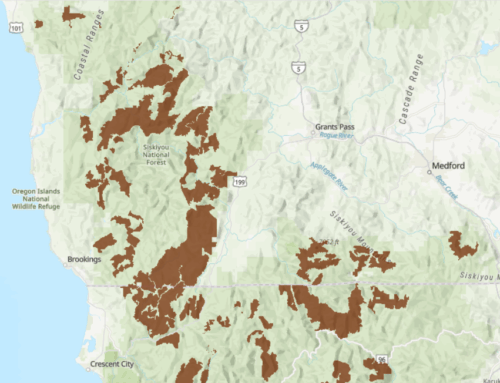The Conservation Column
By Pepper Trail
This last Conservation Column for the “Audubon Year” is a summary of updates on the priority issues for the Oregon Audubon Council, the consortium of Audubon chapters in Oregon. This is an abridged version of the summary prepared by Joe Liebezeit and Bob Sallinger of Portland Audubon. Lots of work being done, lots more to do! Meanwhile, let’s all take the time to get out and enjoy what we’re fighting for: our beautiful Oregon birds and ecosystems.
OAC PRIORITY UPDATES
Defense of federal lands and environmental laws
• The change in administration allows the conservation community to move from defense to offense. There is significant damage to be repaired from the last four years as well as opportunity to advance new initiatives.
• The Biden Administration is working to reverse the Northern Spotted Owl Critical Habitat Rule (reduction of critical habitat). A final rule is expected towards the end of the year. Portland Audubon joined in a lawsuit in March to reinstate protections on 3.4 million acres of critical Northern Spotted Owl habitat. That lawsuit remains in play.
• The Biden Administration is working to reverse the elimination of incidental take under the Migratory Bird Treaty Act.
• The Trump Administration decision not to uplist the Northern Spotted Owl (warranted but precluded) will stand. A lawsuit brought by EPIC et al. (including Portland Audubon) to force the USFWS to make a decision on uplisting has been dismissed since a decision was in fact made (albeit the wrong decision).
• Kalmiopsis Audubon Society advocated for the Southwest Oregon Watershed and Salmon Protection Act to protect the headwaters of our region’s wild rivers from the threat of strip mining. Congressman DeFazio pushed hard to get it into the House public lands bill – the Protect America’s Wilderness and Public Lands Act – which passed the full House in February. We hope that our Senators will advance a companion bill soon.
• Portland Audubon is exploring litigation related to the EIS allowing the killing of more than 120,000 Double-crested Cormorants annually which could place the small western population at significant risk.
Klamath National Wildlife Refuge
• The Klamath is facing one of the worst water crises on record. Klamath Audubon, Portland Audubon and others are convening groups to develop a strategy to generate pressure at the national level to get water to the refuges. Last year more than 40,000 birds died at Klamath due to botulism related to drought conditions.
• Portland Audubon et al. are continuing to challenge the Klamath Comprehensive Conservation Plan through an appeal process to the lawsuit rejected in 2019. Portland Audubon and colitigants are currently discussing an appeal and options for moving forward as well as a bigger picture Klamath strategy for the next few years.
Currently the USFWS released a Draft Environmental Assessment for water supply enhancement for the Lower Klamath NWR which evaluates alternatives for the Service to acquire and transfer water rights from willing sellers. Portland Audubon and partners submitted public comment on this EA on March 14. Here is a link to the draft EA. Our basic comments are that USFWS should more fully consider other water supply sources for Lower Klamath NWR including use of Tule Lake NWR water from leaselands. The comment letter can be provided on request.
Forests
• Oregon Forest Practices Act (OFPA) Reform: In January, formal negotiations got underway between conservation groups and timber companies focused on developing a Habitat Conservation Plan for federally listed aquatic species on private timber lands. Bob Sallinger is one of six conservation representatives in these negotiations. The negotiations have been moving at an intense clip with two two-hour mediation sessions per week.
• Kalmiopsis Audubon Society has collaborated with the Spray Free Coast coalition to conduct trainings to help citizens understand how to use the state FERNS (Forest Activity Electronic Reporting and Notification System), and is also participating as part of the Wild Rivers Forest Collaborative, aiming to influence forest management in a positive way.
Marbled Murrelet
• Uplisting Petition: The decision for the ODFW commission on uplisting from threatened to endangered has now been set for the July 9 ODFW Commission meeting. Portland Audubon and members of the Oregon Wildlife Coalition have been meeting with Commission members to educate them on the need to reaffirm the up-listing. We will likely need to mobilize folks to provide testimony at this virtual meeting.
Greater Sage-Grouse
• The annual SageCon Summit occurred in the winter of 2020. Sage-Grouse continue to decline in Oregon and across the west. Conservation groups are likely to pursue listing under the ESA under the new administration. Stu Garrett of ECAS is representing conservation interests on the SageCon Coordinating Council.
• East Cascades Audubon has been working with local federal and state agencies to improve habitat for Sage-Grouse. This spring ECAS collected seeds of Oregon Sunshine which is an important part of the Sage-Grouse chicks’ diet in the spring. Seeds were plant-ed in “Forb Islands” on private property in Sage-Grouse habitat east of Bend to begin restoration studies for the grouse. ECAS will be monitoring this spring and summer for results.
California Condors
• In March, the USFWS published a final ruling on the California Condor release site in Redwood National Park. The final rule designates this population as experimental and exempts most incidental take “provided the take is unintentional and not due to negligent conduct”. Certain activities are prohibited within 656 feet (200 meters) of an active nest. These include habitat alteration (e.g., removing trees, erecting structures, altering the nest structure or perches near the nest) and significant visual or noise disturbance (e.g., tree felling, chainsaws, helicopter overflights, concrete cutters, fireworks or explosives). There are two exemptions: emergency fuel treatment activities by federal, state, tribal, or local government agencies to reduce the risk of catastrophic wildfires and responses to wildfire or other emergencies.
The Condor release facility may be operating as soon as this fall (2021), but next fall is more likely (2022).
ODFW Reform and Funding
• Portland Audubon and the Oregon Wildlife Coalition successfully recruited and advanced the nomination of Dr. Kathayoon Khalil to the ODFW Commission. Dr. Khalil will broaden representation on the Commission and is expected to be a conservation vote. Her first commission meeting will be in June.
• There are several bills related to ODFW in the 2021 legislature (see highlights at start of this document).
• ODFW has appointed an advisory committee on beaver and a trap check requirements committee that will convene shortly. Portland Audubon has been tapped for the trap check committee. Work on these committees is now beginning.
• Portland Audubon and Humane Society of the United States have been advocating for a task force to look at statewide capacity to address wildlife conflicts and distressed wildlife situations. Both organizations provided invited testimony before the House Agriculture and Natural Resources Committee after ODFW killed an orphaned black bear in Southern Oregon.
Climate Change
• This fall has provided a stark example of what the future might look like under various climate scenarios: Massive fires in Oregon and Washington; drought in the Southwest, Southern Oregon, and Northern California; one of the earliest snowstorms on record in Colorado. The plight of birds is writ large with massive botulism die-offs in the Klamath and hundreds of thousands of birds found dead in New Mexico.
• There are several climate related bills in the 2021 legislative session spearheaded by Oregon Conservation Network (OCN). Audubon has not been particularly active on these bills.
Beavers
• The ODFW Commission rejected a petition to eliminate beaver trapping on federal lands. They have appointed a stakeholder committee to look at this issue in the near future.
• There were two good bills related to beaver in the 2021 legislative session. Unfortunately neither advanced.
Columbia River Hydropower System
• In early 2021, Rep Mike Simpson of Idaho (R) released a proposal to breach the four Lower Snake River Dams. This mammoth proposal marks a major but very controversial development in the decades-long effort to remove the Snake River Dams. It includes a $33 billion implementation fund but also includes several concepts of concern including a suspension of ESA litigation on the Columbia River System for 35 years. Portland Audubon has been tracking this issue and is part of the Save Our Salmon Coalition. The proposal has split the environmental community in terms of strategy with some groups focused on trying to build momentum behind the proposal (and deal with the concerns later), and other groups pushing back on the proposal due to its significant flaws. Portland Audubon has been part of discussions about how to reconcile the two approaches.
Predator Control
• Cormorants: The Trump Administration finalized a rule which will allow large-scale killing of Double-crested Cormorants and potentially put western populations at risk. Portland is looking at strategies to oppose this rule.
• Portland Audubon has been working to ban the bird poison Avitrol via comments to the EPA. Many chapters signed onto comments written by Portland Audubon on this issue.
• Coyotes: Portland Audubon worked to support HB 2728, legislation to prohibit cruel coyote killing contests. However, it appears that this bill has died in the Senate after passing the House.
• Ravens: ODFW and USFWS have brought back a proposal to kill ravens in Baker County to protect Sage-Grouse. The new proposal is better than the one chapters opposed in 2019 (the agencies conceded many of our points), but is still unsupported by science.



Leave A Comment
You must be logged in to post a comment.